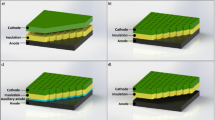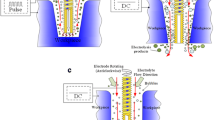Abstract
Turbine blades of aero engines often require small-size and high depth-diameter ratio holes, which have been a promising method for film cooling under harsh working conditions of both high temperature and pressure. However, for the film cooling holes with different spatial angles, existing methods are difficult to eliminate sharp corners that might be damaged easily due to stress concentration and thus reduce the strength of turbine blades. Herein, electrochemical machining (ECM) method based on insulated electrodes was proposed to round the sharp corners of film cooling holes on the GH4169 plate. Electrochemical rounding theory was analyzed in detail. Tube electrodes were insulated by polyimide capillary tube to reduce the stray corrosion and improve the precision and strength of turbine blades. In addition, the size of rounded corners could be adjusted by changing the processing parameters including processing voltage, processing time, processing gap, electrode descent position, and electrode exposure length. This electrochemical rounding process can round the film cooling holes efficiently, and is expected to be applied in the field of aviation manufacturing widely.













Similar content being viewed by others
Data availability
The datasets used or analyzed during the current study are available from the corresponding author on reasonable request.
Code availability
Not applicable.
References
Zhao YC, Gao HS, Wen ZX, Yang YQ, Cheng H, Li Q, Yue ZF (2021) Film cooling of showerhead holes from the twisted leading edge of a gas turbine blade: complex mainstream characteristics and reasonable angle arrangement. Aerosp Sci Technol 119:107208
Wang J, Zhao Z, Tian L, Ren X, Sundén B (2021) Effects of hole configuration on film cooling effectiveness and particle deposition on curved surfaces in gas turbines. Appl Therm Eng 190:116861
Courtis M, Murray A, Coulton B, Ireland P, Mayo I (2021) Influence of spanwise and streamwise film hole spacing on adiabatic film effectiveness for effusion-cooled gas turbine blades. Int J Turbomach Propuls Power 6(3):37
Appalanaidu B, Dvivedi A (2020) On controlling of gas film shape in electrochemical discharge machining process for fabrication of elliptical holes. Mater Manuf Processes 36(5):558–571
Andreini A, Becchi R, Facchini B, Picchi A, Peschiulli A (2017) The effect of effusion holes inclination angle on the adiabatic film cooling effectiveness in a three-sector gas turbine combustor rig with a realistic swirling flow. Int J Therm Sci 121:75–88
Voisey KT, Clyne TW (2004) Laser drilling of cooling holes through plasma sprayed thermal barrier coatings. Surf Coat Technol 176(3):296–306
Li CJ, Li Y, Tong H, Zhao L, Kong QC, Wang ZQ (2016) An EDM pulse power generator and its feasible experiments for drilling film cooling holes. Int J Adv Manuf Technol 87(5–8):1813–1821
Zhang Y, Xu Z, Zhu D, Qu N, Zhu Y (2015) Drilling of film cooling holes by a EDM/ECM in situ combined process using internal and side flushing of tubular electrode. Int J Adv Manuf Technol 83(1–4):505–517
Li Z, Wen Z, Gu S, Pei H, Gao H, Mao Q (2019) In-situ observation of crack initiation and propagation in Ni-based superalloy with film cooling holes during tensile test. J Alloy Compd 793:65–76
Aravind S, Hiremath SS (2022) Design and development of IEG control and characterization of micro-holes generated using in-house developed mu-ECM setup. Arab J Sci Eng 47(7):8877–8898
Zhu LK, Hao JH, Xu B, Wang B (2022) Study on the micro through holes machining using the electrochemical machining (ECM) method with a graphite electrode. Int J Adv Manuf Technol 121(9–10):6049–6057
Liu GD, Tong H, Li Y, Zhong H (2020) Investigation on passivation and transient electrochemical behavior of Fe-Cr-Ni based alloy in micro ECM. J Electrochem Soc 167(6):063503
Wu YY, Sheu DY (2018) Investigating tungsten carbide micro-hole drilling characteristics by desktop micro-ECM with NaOH solution. Micromachines 9(10):512
Wang JY, Sheu DY (2016) Developing a process chain with WEDG technology and pulse ECM to fabricate ultra micro pins. 18th Cirp Conference on Electro Physical and Chemical Machining (Isem Xviii) 42: p 815–818
Han W, Kunieda M (2017) Fabrication of tungsten micro-rods by ECM using ultra-short-pulse bipolar current. CIRP Ann Manuf Technol 66(1):193–196
Liu GD, Li Y, Kong QC, Tong H (2017) Research on ECM process of micro holes with internal features. Precis Eng 47:508–515
Wu B, Wu XY, Lei JG, Xu B, Ruan SC, Zhong JM (2017) Study on machining 3D micro mould cavities using reciprocating micro ECM with queued foil microelectrodes. J Mater Process Technol 241:120–128
Zhang Y, Xu Z, Zhu Y, Zhu D (2016) Machining of a film-cooling hole in a single-crystal superalloy by high-speed electrochemical discharge drilling. Chin J Aeronaut 29(2):560–570
Lee E-S, Won J-K, Shin T-H, Kim S-H (2012) Investigation of machining characteristics for electrochemical micro-deburring of the AZ31 lightweight magnesium alloy. Int J Precis Eng Manuf 13(3):339–345
Sarkar S, Mitra S, Bhattacharyya B (2004) Mathematical modeling for controlled electrochemical deburring (ECD). J Mater Process Technol 147(2):241–246
Funding
This work was supported by the Natural Science Foundation of Liaoning Province (Grant No. 20170540709).
Author information
Authors and Affiliations
Corresponding author
Ethics declarations
Ethics approval
Not applicable.
Consent to participate
Not applicable.
Consent for publication
All the authors declare their consent for the publication of the manuscript after acceptance.
Conflict of interest
The authors declare no competing interests.
Additional information
Publisher's note
Springer Nature remains neutral with regard to jurisdictional claims in published maps and institutional affiliations.
Rights and permissions
Springer Nature or its licensor (e.g. a society or other partner) holds exclusive rights to this article under a publishing agreement with the author(s) or other rightsholder(s); author self-archiving of the accepted manuscript version of this article is solely governed by the terms of such publishing agreement and applicable law.
About this article
Cite this article
Sun, Y., Zhang, Y., Ma, N. et al. Highly-efficient electrochemical rounding process of sharp corner improved by a tube electrode insulation method. Int J Adv Manuf Technol 127, 295–304 (2023). https://doi.org/10.1007/s00170-023-11545-4
Received:
Accepted:
Published:
Issue Date:
DOI: https://doi.org/10.1007/s00170-023-11545-4




